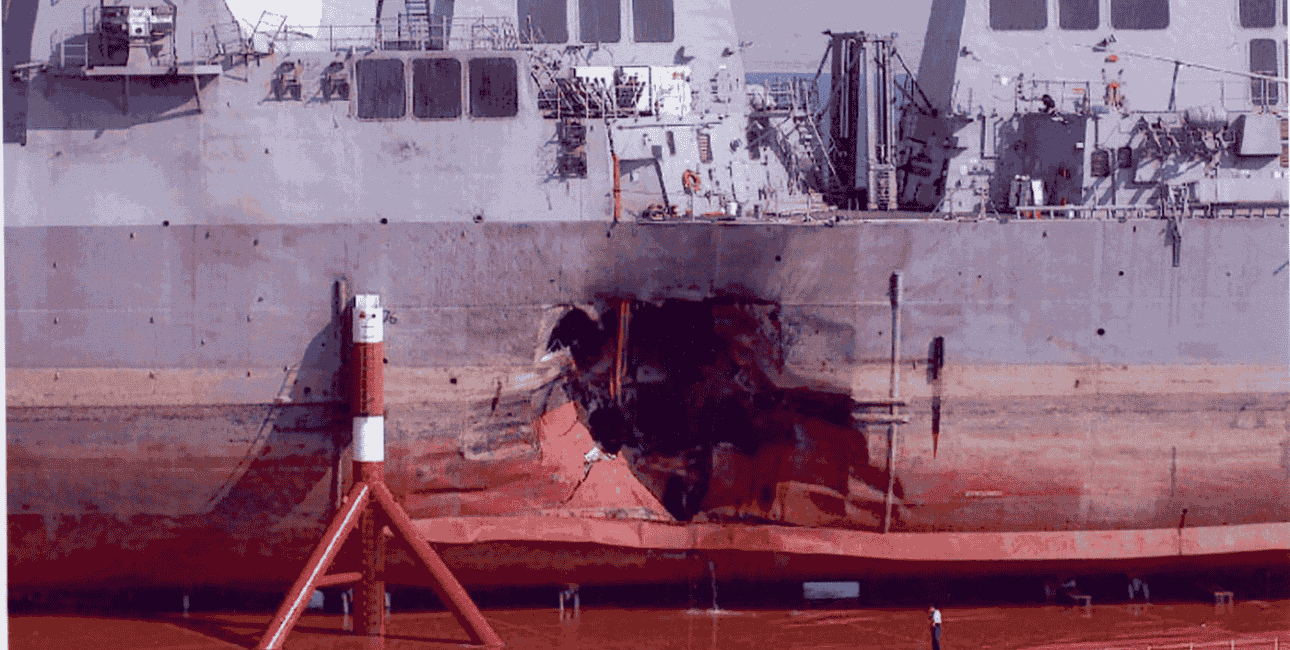Worst Terror Attack On U.S. Navy: How Al Qaeda Bombers Almost Sank USS Cole, Killing 17 Sailors Aboard

Twenty-five years ago, the US Navy’s guided destroyer USS Cole was hit by one of the most barbaric terrorist attacks in the history of the American Navy.
On October 12, 2000, USS Cole was refuelling at the Aden port in Yemen when it was attacked by suicide bombers. The attack was orchestrated by the terrorist outfit Al Qaeda, foreshadowing the barbaric 9/11 attacks in which 2,977 people were killed.
The Cole bombing in Yemen killed 17 sailors and injured 37 crew members. However, in the aftermath of the attack, the remaining crew on the vessel demonstrated exceptional courage and resilience over the next 96 hours, carrying out uninterrupted damage control to save the ship.
The ship was saved from sinking despite a massive hole in the port side.
As noted by the US Naval History and Heritage Command, “Cole carried out emergent repairs and on 29 October stood out of Aden. The following day, MSC [Military Sealift Command]-manned heavy lift vessel Blue Marlin loaded the destroyer on board and sailed her to Pascagoula for extensive repairs, reaching that port on 13 December. Cole’s crewmembers were flown to Rhein-Main AFB, Germany, and from there to Norfolk, VA. Cole’s Sailors then completed convalescent leave through 1 December, and the ship returned to the water on Christmas Eve and continued repairs and maintenance into 2001.”
A key suspect linked to the attack, Jamal al-Badawi, was killed during Donald Trump’s first term in office.
“Our GREAT MILITARY has delivered justice for the heroes lost and wounded in the cowardly attack on the USS Cole,” Trump announced in January 2019. “We have just killed the leader of that attack, Jamal al-Badawi. Our work against [Al-Qaida] continues. We will never stop in our fight against Radical Islamic Terrorism!”
The impact of the attack was on display when netizens started recounting the horrors of the Cole Bombing, when USS Harry S. Truman aircraft carrier collided with a cargo ship in February 2025, as reported by the EurAsian Times at the time.
One netizen wrote: “What if the ship that collided with the USS Harry S. Truman was manned by terrorists and packed with explosives? The Captain’s incompetence in allowing it so close could have gotten his crew killed and humiliated the US.”
The Cole Bombing
On August 8, 2000, USS Cole (commanded by Kirk S. Lippold) was deployed from Norfolk to the Mediterranean, Red Sea, Gulf of Aden, and Indian Ocean, alongside the oiler USNS John Lenthall, manned by the Military Sealift Command (MSC), and the guided missile frigate Simpson (FFG-56).
On the fateful day of October 12, 2000, USS Cole made a refuelling stop at Aden Port, Yemen, while it was en route to the Persian Gulf.
While the ship was still docked for refuelling, a small fiberglass speedboat approached the port side of the ship. The two people on the small boat offered friendly gestures to several crew members, as the FBI later recounted.
However, the crew and commander of USS Cole did not know that this small boat was carrying about 1,000 pounds (450 kilograms) of C4 explosives molded into a shaped charge. Moreover, the crew had limited time to assess the situation, especially since the boat did not display overtly threatening behavior, and the rules of engagement (ROE) did not permit firing unless a clear intent of hostility was established.
The two suicide bombers aboard detonated the explosives, ripping a 40-by-60-foot (12-by-18-meter) gash in the hull.
The blast occurred near the ship’s galley, where crew members were gathering for lunch, pushing up the deck and causing severe damage to engineering spaces. 17 sailors were instantly killed by the blast, while about 40 were injured, and many others were trapped and had to be rescued later.
The attackers, identified as Ibrahim al-Thawar and Abdullah al-Misawa, died in the explosion as intended. This was the first significant international terrorist attack on a US facility since the US embassies in Africa were bombed in 1998.
Following the explosion, the USS Cole’s crew worked nonstop to rescue others who were trapped by the twisted wreckage and prevent water that could have sunk the ship.
The crew acted quickly to isolate damaged electrical systems and contain fuel oil ruptures, saving the ship from devastating fires that would have destroyed the lives of several people on board. The crew’s expert first aid and cutting-edge medical care saved many lives and alleviated the agony of countless others.
“Drawing upon their Navy training and discipline, the crew heroically conducted more than 96 hours of sustained damage control in conditions of extreme heat and stress. Deprived of sleep, food, and shelter, they vigilantly battled to preserve a secure perimeter and restore stability to engineering systems that were vital to the ship’s survival,” states the US Navy.

The heavy-lift ship MV Blue Marlin, operated by a Norwegian company, hauled the Cole from Aden on October 29, 2000, and it reached Pascagoula, Mississippi, on December 13, 2000, for repairs. It was extensively rebuilt and put back into active service in 2001.
The FBI quickly sent more than 100 agents from the Counterterrorism Division, the FBI Laboratory, and various field offices to Yemen. Several FBI field offices and legal attaches, several hundred FBI agents and support staff, and Joint Terrorism Task Force personnel ultimately took part in the investigation.
After a thorough FBI investigation, it was concluded that the bombing was planned and executed by members of the Al-Qaeda terrorist network.
The investigators determined that the USS Cole explosion came after an unsuccessful attempt to destroy another US Navy ship, USS The Sullivans, on January 3, 2000.

Both the terrorist boat and the explosives were recovered in that previous event, but the boat had sunk before the explosives could be detonated. The boat was then refitted, and the explosives were tested and reused in the USS Cole attack.
In December 2000, Yemeni officials arrested two suspects—Fahd al-Quso and Jamal al-Badawi, and identified Abd al Rahim al-Nashiri as a key figure in the bombing.
A month later, in January 2001, the Pentagon’s Crouch-Gehman Report analyzed the bombing, noting significant challenges in preventing such attacks due to ambiguous rules of engagement and intelligence gaps, while identifying shortcomings in force protection measures during international transits.
Notably, in March 2001, Al Jazeera ran a broadcast that showed Al Qaeda terrorist Osama Bin Laden (later slain by the US military in Abbottabad in Pakistan) reading a poem about the incident.
”In Aden, the young man stood up for holy war and destroyed a destroyer feared by the powerful,” he was heard saying. Later that year, a video circulated showing followers of bin Laden training in Afghanistan, singing, “We thank God for granting us victory the day we destroyed Cole in the sea.”

Key planners Al-Badawi and Al-Quso were later murdered in separate US airstrikes, and the US Navy built the USS Cole Memorial, which was dedicated to the slain sailors and survivors on October 12, 2001.
Two years after the Cole Bombing, Al-Qaeda allegedly bombed the French oil tanker MV Limburg using a similar suicide boat method to the Cole attack, killing one crew member and spilling oil in the Gulf of Aden.
The US intelligence linked it to the same network targeting US naval assets in the region, prompting heightened Navy patrols in the Gulf of Aden. The incident reinforced Al-Qaeda’s maritime terrorism strategy against Western interests, including potential US ships.
However, after the Cole Bombing, the US Navy slightly expanded ROE to allow commanding officers greater discretion to engage potential threats proactively. In fact, the new guidelines permitted the use of force against vessels or individuals displaying suspicious behavior.
More importantly, though, the Navy implemented rigorous anti-terrorism/force protection (AT/FP) training programs to avert a similar tragedy.
Additionally, the Navy strengthened coordination with intelligence agencies to improve real-time threat assessments and took significant steps to enhance port security.
In a nutshell, the Cole Bombing rattled the US Navy in a way that it took every possible step to make sure that no other vessel belonging to the service would ever be hit by an unforeseen terrorist attack.
- Questions and Answers
- Opinion
- Motivational and Inspiring Story
- Technology
- Live and Let live
- Focus
- Geopolitics
- Military-Arms/Equipment
- Beveiliging
- Economy
- Beasts of Nations
- Machine Tools-The “Mother Industry”
- Art
- Causes
- Crafts
- Dance
- Drinks
- Film/Movie
- Fitness
- Food
- Spellen
- Gardening
- Health
- Home
- Literature
- Music
- Networking
- Other
- Party
- Religion
- Shopping
- Sports
- Theater
- Health and Wellness
- News
- Culture

